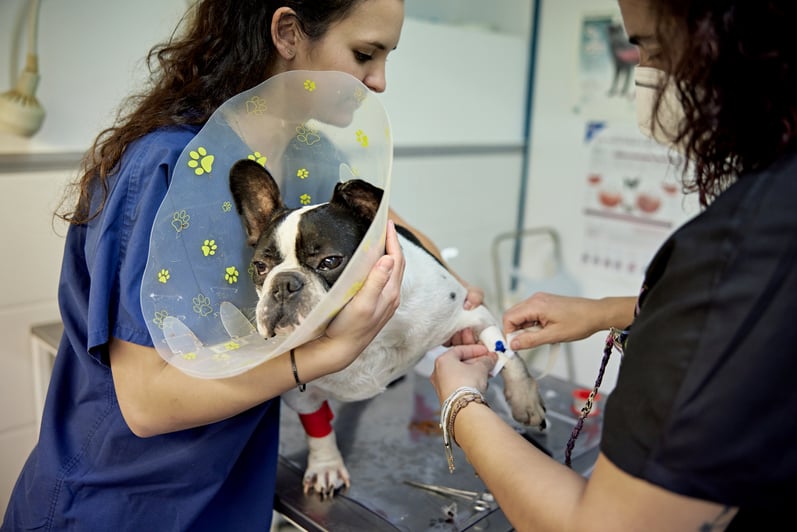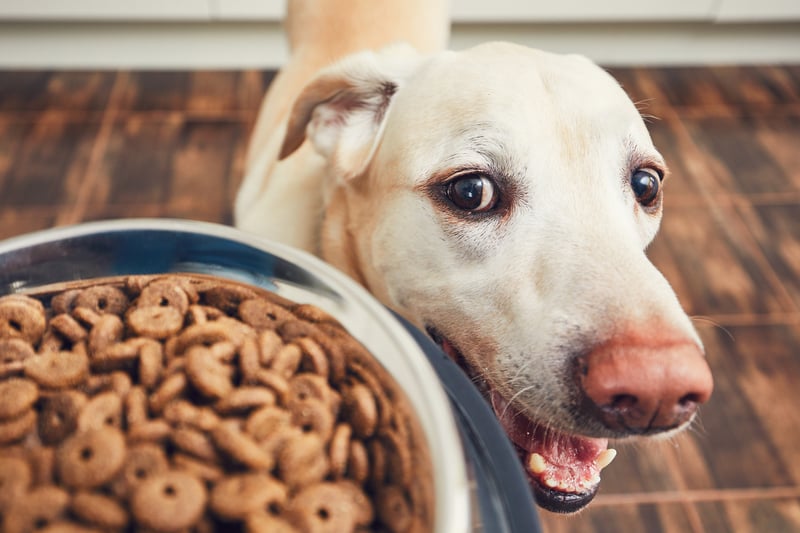Table of Contents
You love your dog, but when you look at them, you can't help but wonder – what are they made of?
And we don’t mean the sunshine, snuggles, and playful energy that make up your pup’s personality!
We’re talking about their internal structure – their skeleton and bones.
And like any good pet parent, you may be wondering how to keep their bones healthy and strong. This article will provide an overview of the anatomy of the dog skeleton, as well as offer some tips on keeping your dog's bones in good health.
Dog Bone Anatomy
Like a house, your dog’s body has a “foundation” that it rests on. It supports the rest of your dog’s body and helps it function properly, all while holding it up. These hard structures are all different sizes and shapes, and are supported by soft tissue structures like tendons, ligaments, and muscles. Like a house, each of these components must remain in tip-top shape to keep supporting your dog’s mobility. Each bone and structure plays a unique role in your dog’s motion.
The dog skeleton is made up of 321 bones, including several different types of bones.
The different types of dog bones include:
- Long: Located in each of your dog’s four limbs
- Short: Located in the wrist and ankles of your dog’s body
- Flat: Located in the pelvis and skull
- Sesamoid: Located near free-moving joints, such as the wrist and knee
- Irregular: Includes all bones in the spinal column, all bones in the skull other than the flat ones, and three in the hip
Each bone serves its own unique function, but most bones are composed of the same layers of tissue. These bone components need to be maintained and kept healthy in order for your pup to have healthy dog bones overall.
The table below outlines the various tissues inside dog bones.
|
Dog Bones Tissues |
Description |
|
Periosteum |
The outer layer of a bone is covered by a fibrous membrane called the periosteum. A large part of this membrane is made up of capillaries that nourish the bones with blood. |
|
Cortical Bone |
Cortical bone makes up 80% of skeletal bone mass. Most of the body's weight is supported by the cortical bone. |
|
Cancellous Bone |
Honeycomb-like inner spongy structure of the bone. 20% of bone mass is made up of cancellous bone. The meshwork of this spongy bone is specifically designed to provide strength and behaves similarly to the steel rebar rods embedded in concrete. |
Also found inside dog bones is marrow. Bone marrow is located in the hollow center shaft of the bone, also known as the medullary cavity. This spongy, squishy material plays an important role in good bone and overall dog health. Many of the dog's circulating blood cells are produced in this organ. Additionally, bone marrow contains blood, fat, connective tissue, and blood vessels.
In order to get a snapshot of the most important dog bones in the body, consult the labeled dog bones anatomy diagram below to see where these bones are located and how they connect to each other.
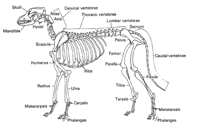
In addition to serving as muscle levers, dog bones also store calcium and phosphorus, among other elements. If they are not provided with the right diet, healthcare, and exercise, they will become weak and fragile.
Dog Joint Anatomy
A joint is the connection between two bones that allows movement between them.
There are three types of dog joints anatomy to be aware of:
- Synovial
- Fibrous
- Cartilaginous
They're surrounded by a joint capsule (a ligamentous membrane surrounding the ends of bones which enables movement), articular cartilage (a smooth connective tissue covering each end of a bone at its joint), and synovial fluid (lubricates cartilage surfaces).
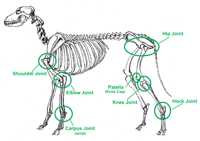
Each joint plays an important role in the motion and function of your dog’s mobility and should be maintained carefully. Over time, joints can degrade, losing the cushion between bones, causing the bones to rub together and creating pain for your poor pup. With less cartilage to pad the bones, your pup can encounter arthritis.
Repairing and protecting your dog’s cartilage can be done with the help of ingredients like chondroitin and glucosamine for dogs found in dog joint supplements. These can help reduce the pain your pup feels when they move and stop cartilage from degrading beyond the point of no return.
Dog Tendon Anatomy
Tendons are tough fibrous cords of tissue that connect muscles to bones. They're located in the body's joints, and they're made of a substance called collagen – the same substance that makes up our own skin, hair, and nails. Tendons attach muscles to bones so they can produce motion by contracting or relaxing as needed.
Tendons are often confused for ligaments when discussing dog bones. Refer to the chart below to understand the difference between ligaments and dog tendon anatomy.
|
Type of Structure |
Description |
Example |
|
Tendons |
Tendons are tough fibrous bands connecting muscles to bones. The tendon begins on a muscle and ends on a bone. |
Achilles Tendon |
|
Ligaments |
Ligaments connect bone to bone, like in a spanning joint. The ligaments begin on a bone and end on a bone. |
Cranial Cruciate Ligament |
These tough little guys get a lot accomplished for your dog. The science behind why they do their job so well involves terms like elasticity and strength. When connected correctly with other parts of the dog’s body, these fibers allow both movement capability plus protection against injury via their ability to stretch without breaking apart during physical activity.
You’ll often hear terms like “cranial” attached to ligament names. The reason is that it indicates where in the dog’s body it’s located, kind of like a map notes North or East. The chart below outlines how these directions, or planes, are described by vets.
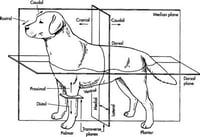
Common Dog Bones Health Concerns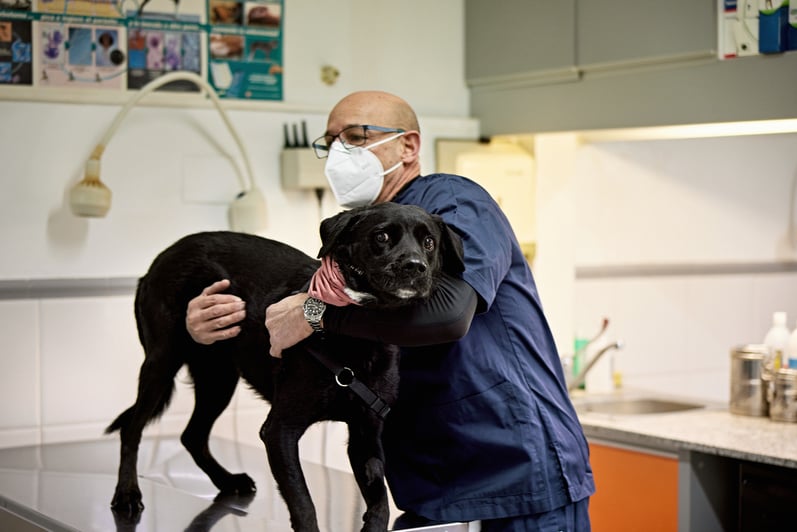
From tiny terriers to massive Newfoundlands, dogs all have different personalities and characteristics. However, what unites them all is their bones and skeletal structures. While the differences between the sizes of bones can depend on your dog's breed and age, what remains consistently important across the board is maintaining their bones' health.
We're going to take a look at the most common health concerns related to dog bone health and how best to avoid problems. So read on and learn everything you need to know to maintain safe, healthy, and strong bones.
Health Concern #1: Arthritis
Dog arthritis is a common health concern among dogs of all ages. It's a degenerative condition that can cause inflammation, stiffness, and pain in your pet's joints.
The primary cause of dog arthritis is wear and tear on the cartilage that cushions the ends of bones inside joint sockets. This wear and tear may be caused by inflammation, trauma or injury, but some breeds are known to develop osteoarthritis (OA), which is more likely to occur due to genetic factors.
Some of those breeds more likely to develop arthritis and dog bone problems than others include:
- Rottweilers
- Malamutes
- Labradors
- Golden retrievers
- German shepherds
Symptoms include lethargy, limping, and stiffness following exercise. If left untreated, OA can lead to permanent loss of mobility for your dog.
That’s why it’s important to visit with your vet as soon as you can, so they can conduct an exam and determine the severity of your case of dog arthritis. During this procedure, your vet will examine your dog's joint capsule to see if it has thickened or if your pup is experiencing pain when it is palpated. It is also possible that they will order an MRI or an X-ray.
Another key step to take in managing arthritis? Feeding supplements to your pup!
TRI-ACTA H.A. for Pets is designed to repair their damaged cartilage, prevent further deterioration, and to reduce inflammation. It will treat the cause AND the painful symptoms when there is a mobility concern like arthritis at play. Additionally, if you have a large breed dog or a pup with a history of mobility challenges, it can play a critical role in delaying the onset of osteoarthritis.
TRI-ACTA H.A. for Pets
Our maximum strength formula is optimally designed to accelerate the formation of cartilage, minimize inflammation, expedite the healing process, and improve joint conditions.

Health Concern #2: Hip Dysplasia
Hip dysplasia is a common joint disorder in dogs. It's characterized by abnormal development of the hip socket, which can lead to arthritis and pain. Hip dysplasia may be present at birth or develop later in life.
In the hip joint, there is a ball and socket joint. For the hip joint to function properly, these are supposed to grow uniformly as your puppy grows. With the ball perfectly positioned in the socket, the dog's legs and hips can move freely. Hip dysplasia, on the other hand, causes the ball and socket to be disproportionately sized. As a result of this condition, the joint becomes loose to varying degrees, depending on the severity.
Despite the genetic predisposition for this condition in larger dogs, this condition can also occur in smaller dogs like French Bulldogs and Pugs.
Symptoms of dog bones hip dysplasia include:
- Limping
- Stiffness
- Trouble getting up after resting or sleeping on one side
- Skipping
If your dog is diagnosed with a dog joint health problem like hip dysplasia, talk with your veterinarian about treatment options. Surgery is an option for some dogs with mild or moderate cases of hip dysplasia but may not be necessary for all cases of the condition. If surgery isn't recommended for your dog's condition, you can help manage symptoms by giving them glucosamine supplements and reducing stress on their hips whenever possible.
But why can these supplements help manage your sweet pup’s pain?
When a dog has hip dysplasia, there is often a misalignment in the joint structure. This can cause the cartilage in the joint structure to wear away at faster rates, which increases the chances of developing osteoarthritis at earlier stages in life. Glucosamine is one of the key joint health ingredients that helps to fight that joint degradation. TRI-ACTA for Pets can help normalize the function of the affected joint, prevent further deterioration and delay the onset of osteoarthritis.
Health Concern #3: Bone Infection
Bone infections, while uncommon overall, can definitely pose a risk to your pup’s bone health if you miss the signs.
There are two main types of bone infections, and they have similar symptoms:
- Osteomyelitis
- Osteonecrosis
Osteomyelitis is a type of bone infection that occurs when the blood supply to the bone is blocked, preventing it from healing properly. When this happens, bacteria get into the space between the bones where blood would normally circulate and start to grow there instead. The resulting inflammation can cause pain and lameness as well as fever in dogs with this condition.
Osteonecrosis, on the other hand, is rarer, and typically affects the maxillofacial (jaw, face, and mouth) region. The term osteonecrosis refers to the death of a segment of bone that results in architectural collapse, pain, and loss of function. The causes of osteonecrosis include trauma, dental disease, infections, radiation treatment, and systemic medication.
When your dog has a hip or knee joint problem due to arthritis or injury, they may need surgery to repair it. However, doing so can sometimes lead to a bone infection if not done correctly. That can be due to surgical trauma, which damages blood vessels supplying nutrients needed for healthy bone growth.
If you notice any signs of discomfort from your pet’s joints – limping, especially when walking or standing up – these could be symptoms that something may be wrong with their bone structure such as an osteomyelitis or osteonecrosis infection.
If left untreated over time, these conditions can become more serious so make sure you take them seriously by contacting your veterinarian if anything seems off!
Health Concern #4: Metabolic Bone Disorders
Metabolic bone disorders are also called metabolic bone diseases. This can include conditions like osteodystrophy, rickets, and osteomalacia.
Metabolic bone diseases occur when there’s a problem with how the body uses calcium, phosphorus, and vitamin D.
This can be caused by a myriad of things, including:
- Lack of Vitamin D from the sun or from supplements
- Kidney disease
- Too little protein in the diet
- Genetic factors
In the case of large breeds such as the German Shepherd or Great Dane, these conditions and others related to bones and bone development affect them disproportionately. It's important to know that dogs can have metabolic bone diseases without any major symptoms.
Watch out for dog bones symptoms including:
- Unexplained weight loss
- Weak bones and fragile joints that easily fracture during activities such as running or jumping
- Swelling around joints like elbows
- Limping
It is essential to manage pain during the treatment of these conditions. It is sometimes necessary to administer intravenous fluid therapy to dogs with metabolic bone disorders who have systemic symptoms. The most effective treatment for dogs with metabolic bone disorders is surgery, although anti-inflammatories and pain medications can be used to alleviate symptoms.
Health Concern #5: Bone Cancers
Bone cancer, sometimes osteosarcoma, is a type of malignant tumor that forms in the bone. Osteosarcoma arises from abnormal bone-building and bone-breaking cells (osteoblasts and osteoclasts).
The most common sites for bone cancer to develop are:
- Spine
- Skull
- Long bones of the legs (femur, tibia, fibula)
- Ribs (costochondral junction)
- Short bones of the forelimbs and hindlimbs
Bone cancer is usually detected by your veterinarian during a routine physical examination, although it may be more difficult to detect in smaller breeds. Your veterinarian may notice an abnormality on x-rays or other imaging techniques such as ultrasound or CT scan, which will be used to confirm the diagnosis.
Bone tumors can also cause pain and lameness in dogs with advanced disease, so they may have difficulty walking normally due to pain or weakness caused by tumors spread into adjacent structures such as muscles or nerves within the limb where they occur.
Treatment options vary depending on whether tumors are localized at one site or have spread throughout multiple tissues throughout their entire body. However, all forms require aggressive treatment such as surgery followed by chemotherapy or radiation if possible.
Dog Bones Health Maintenance Tips
All dogs need to maintain their skeletal and bone health. Just like humans, bones are living tissue that needs to be cared for. If you don't take care of your dog's bones, they can become weak, brittle, or broken.
When you see your vet for a checkup, they will ask you some questions about your dog's lifestyle and diet. They'll also want to know if they have any problems with their bones or joints.
If there are any changes in your dog's behavior or mobility, it could be a sign that they're in pain or discomfort. This could be due to arthritis or joint problems.
Read on to find out about how to prevent problems in dog bones.
Tip #1: Feed a Joint Supplement
Before you start a dog supplement program, it's important to consult your vet. Your vet will be able to help you choose the right supplements for your dog based on his or her age, size, and breed.
A vet-approved dog supplement program will provide the proper vitamins and minerals that are required for optimal canine health. If a dog is not getting enough of these nutrients through its diet, it can cause health issues such as skin irritation and dull coat coloration.
Some dogs suffer from joint pain or arthritis due to their breed or lifestyle-related activity. Joint supplements may also help alleviate those symptoms. Glucosamine and chondroitin are commonly recommended ingredients in these products because they help repair and protect cartilage damaged by inflammation. As such, they are particularly useful when paired with calcium supplements.
Tip #2: Balance Your Dog’s Diet
A balanced diet is key to maintaining optimal dog bones health.
The primary materials key to dog bone health include:
- Calcium
- Vitamin D
- Magnesium
- Phosphorus
Commercially blended foods (also known as "commercially complete" diets) are scientifically blended to balance these key ingredients. That’s thanks to standards set forth by the Association of American Feed Control Officials (AAFCO) of what can be included in commercial pet foods manufactured for sale in North America. These regulations require that any commercially blended product meet certain nutritional requirements before being sold as such.
When you're feeding your pup a DIY diet, it's important that you have a good understanding of the components that contribute to dog bone health in order to ensure your dog gets all the nutrients they need. This means that if you do feed a raw food diet for dogs at home but want one with similar benefits as commercially complete diets, you could go the route of buying packaged fresh raw foods from the store. This is convenient but also expensive!
If you’re making raw food, it’s best to not only know which minerals contribute directly toward supporting strong bones but also how much should be added per meal to avoid deficiencies in minerals like calcium. In general, you want a 1:1 balance of calcium and phosphorus, but meat itself naturally has more phosphorus than calcium. So, you’ll want to try either adding safe-to-eat dog bones or a calcium supplement to their food to keep their dog bones healthy.
Tip #3: Exercise Often
If you want your dog to have strong bones, it helps to get them moving! That’s because exercise strengthens muscles and increases bone density.
A brisk walk or a swim are great ways to get started. A game of fetch is also a fantastic way for your pup's body to stay healthy – the act of chasing and catching the ball will strengthen their legs while they run around while giving them both mental stimulation as well as physical activity.
Exercise is important for maintaining healthy joints as well: weak muscles can't support good bone health, which is why consistent exercise routines are so vital for keeping pups happy and healthy throughout their lives. Just remember that with all forms of physical activity comes risk – be sure not to overdo it!
Keep an eye on how much energy your four-legged friend has left after playtime, and avoid doing any activities where there's even a remote possibility that injury could occur if your pet pushes itself too hard before recovering from previous wear-and-tear in his joints (known colloquially as "weekend warrior syndrome").
Tip #4: Check-In With Your Vet
One of the most important things you can do for your dog's bone health is to bring them to the vet regularly. The vet will be able to tell you if there are any problems with your dog's bone health and help you maintain good health for years to come. They can also conduct physical exams and check vitals, and administer vaccinations if needed.
Your vet will also be able to recommend other preventative measures that will keep your dog's bones healthy for life. If you've had a dog for a long time, then chances are good that your vet has seen many of their bones and knows their specific history. This helps them make specific recommendations for your pup.
Final Thoughts
The skeletal system and dog bones provide support for your pet's muscles, tendons, and ligaments so they can function properly. It also protects organs like their heart, lungs, and kidneys from injury during normal activities like walking around or playing with other pets or people.
And to make dog bones strong and healthy, you’re going to need a powerful supplement to combat signs of painful dog bones health problems. Our maximum strength formula, TRI-ACTA H.A. for pets is just what pets need when they're recovering from a dog bones injury. And when you're focused on prevention for younger, healthy dogs, try TRI-ACTA for pets. We make our formulas with glucosamine and chondroitin, plus other helpful joint-supporting ingredients, as well as quality assurances you know your pet deserves.
TRI-ACTA for Pets
A proactive approach for developing and younger adult pets to maintain optimal joint health mobility, minimize inflammation and fend off age-related ailments.
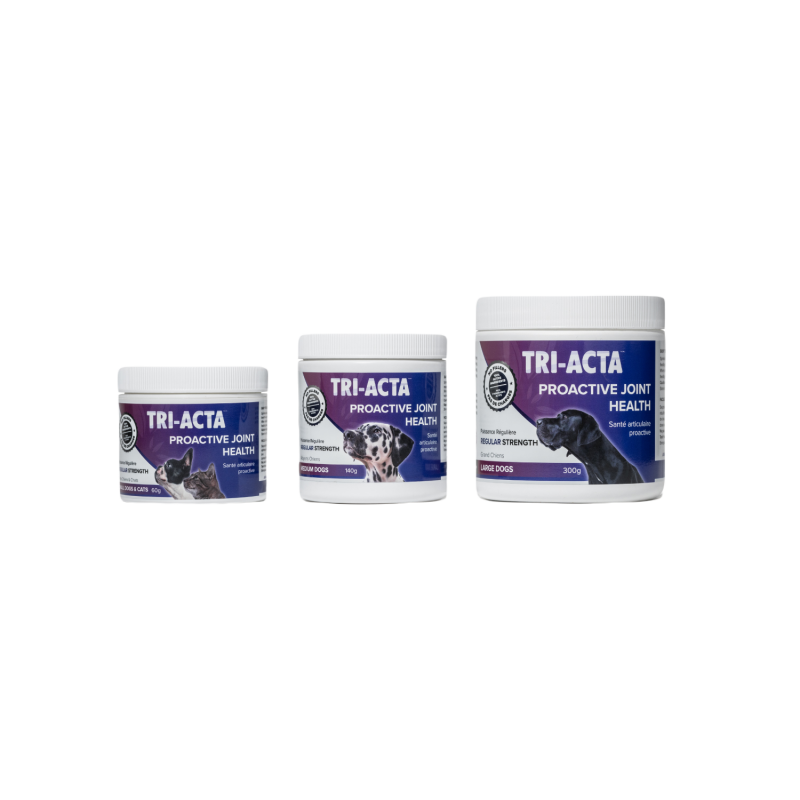
Find out where to buy TRI-ACTA, and read our blog for more helpful pet health tips.
Newsletter Signup
Subscribe to our newsletter to receive the latest news and exclusive offers.
.jpg?height=2000&name=Cliick_Integricare-DISPLAY-REVISEDV2%20(1).jpg)
Proactive & Therapeutic Joint Supplements
When given daily, Integricare joint supplements recover bone and joint injuries faster and help prevent mobility injuries from happening in the first place.



